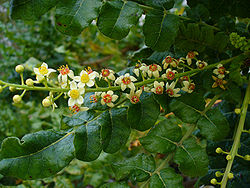But global warming isn't the culprit on this one, it is most likely insect attack. Frankincense is obtained by tapping various species of Boswellia, a tree that grows in the Horn of Africa and the Arabian peninsula. Yet despite its economic importance – incense has been traded internationally for thousands of years – little is known about how tapping affects Boswellia populations.
Naturally, ecologists have assumed tapping might be the issue in the decline, even though it has been done for thousands of years. Large-scale field studies were conducted and they found that tree numbers could decline by 90% in the next 50 years if fire, grazing and insect attack – the most likely causes of the decline – remain unchecked.
Working in an isolated part of north-west Ethiopia near the source of the Blue Nile the team, led by Dr. Frans Bongers of Wageningen University, studied 13 two-hectare plots, some where trees were tapped for frankincense and some where they were untapped. Over two years, they monitored survival, growth and seed production of more than 6,000 Boswellia trees, collecting over 20,000 individual measurements.

Boswellia tree. Credit: Wikipedia
They then used this data to construct demographic models capable of predicting the fate of Boswellia populations in coming years. Alarmingly, the model shows Boswellia populations are declining so dramatically that frankincense production could be halved in the next 15 years.
According to Bongers, "Current management of Boswellia populations is clearly unsustainable. Our models show that within 50 years populations of Boswellia will be decimated, and the declining populations mean frankincense production is doomed. This is a rather alarming message for the incense industry and conservation organisations."
They found all populations they studied are declining, not only those from tapped stands of trees, suggesting that factors other than tapping are at the root of the problem.
"Frankincense extraction is unlikely to be the main cause of population decline, which is likely to be caused by burning, grazing and attack by the long-horn beetle, which lays its eggs under the bark of the tree," said Bongers.
In the areas they studied, the team found that as well as high levels of mortality among adult trees, the older trees in the population were not being replaced because few Boswellia seedlings survived to become saplings.
"The number of fires and intensity of grazing in our study area has increased over recent decades as a result of a large increase in the number of cattle, and this could be why seedlings fail to grow into saplings. At the same time, a large proportion of trees we studied died after being attacked by the long-horn beetle," Bongers explained.
He says strong and far-reaching management incentives need to be introduced if Boswellia populations – and future frankincense production – are to be preserved.
In the short term this involves preventing fires and beetle attack, although the latter is difficult because scientists know little about its lifecycle. In the long-term, Bongers says areas should be set aside and protected from fire and grazing for 5-10 years to allow Boswellia saplings to become established.






Comments